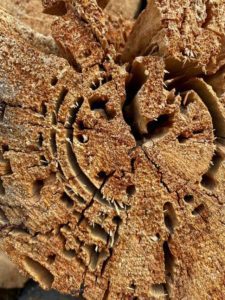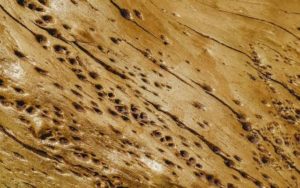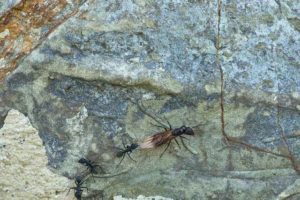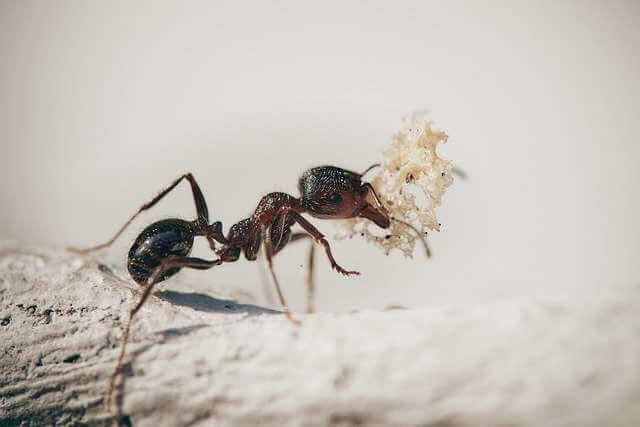Carpenter ants are devastating destructive pests that can cost you thousands if they go untreated. Learn their habits and how to spot their silent activity in your home. This article is complete with Frequently Asked Questions about carpenter ants and how we treat for these pests.
If you’re looking to know how we treat carpenter ants right away, give us a call at 651-342-9489.
Table of Contents
- Carpenter ants
- Signs of carpenter ants in house
- FAQs about carpenter ants
- How we treat for carpenter ants
- Conclusion & next steps
Carpenter Ants
Carpenter ants are large black ants in Minnesota, which don’t eat wood, like termites, but do build with wood like their name suggests. Carpenter ants are destructive to homes and businesses.
They build their nests in wood or plastic-like building materials found in homes. They also build their nests in telephone poles, tree stumps, and other wood sources found outside of homes. Major colonies can house 10,000 to 20,000 carpenter ants.

Their colonies have one queen that lays eggs. Worker ants go out in search of food for the queen. There are often several satellite colonies in route to a food source.
Because they can build with wood, carpenter ants aren’t always a nuisance. In forests, they help with natural decomposition. But in homes and businesses, they can cause damage with decomposition.
In their colonies, carpenter ants build passageways or tunnels throughout. If you have a wooden fence post or something and notice these tunnels, the culprit is most likely carpenter ants.
Carpenter ant colonies are smoother on the inside than termite colonies. Termite colonies typically have mud packed throughout their tunnels within their colonies.

Termites are less likely in the northern United States due to the extreme cold weather of winter. So if you see big black ants in Minnesota, they are typically carpenter ants.
Food
If carpenter ants don’t eat wood, what do they eat? Carpenter ants are both scavengers and predators. They eat parts of dead insects as well as hunting and killing insects for a meal. They can eat crumbs and table scraps from homes too.
Because these insect pests are nocturnal, they hunt for dead insects and food at night. When they find a dead insect, carpenter ants actually extract its body fluid and bring it back to their nest for a food source.
These ants are travelers when it comes to foraging trails. They can make trails in length 300 feet, or the size of a football field!
The other type of food these pests eat is the honeydew collected from insects like aphids, or sweet nectar from peony buds. Ants actually help peonies bloom!
Fun fact: at any given time, only 10% of a carpenter ant colony is out searching for food.
Nests
It can take a queen several years to establish a nest, but these pests are steady in growth in the beginning and can grow exponentially once larger.
Typically carpenter ants build their main nests in high humidity areas. Their satellite nests do not have to be built in high humidity areas.
The reason for building their main nests in high humidity areas are for optimal egg storage and hatching conditions.
The main nest is home to the queen, eggs, newly hatched larvae, and worker ants.
The satellite nests are home to older larvae, pupae, winged carpenter ants, and worker ants.
Mating
Once the ants hatch, they undergo molting process to change from larvae into pupae, and then pupae into adult. New adult ants emerge with wings.
Winged ants signify that they have reached sexual peak. Most ant species, and even some bee species, undergo a mating ritual called nuptial flight.
Ants only mate once in their lifetime, and males die off after mating.
During this nuptial flight, females (or virgin queens) try to out fly and out maneuver the males in order to ensure that only the fittest male mates with her.
The male’s sperm is stored in a specific organ in the queen called a spermathecal, which will last the entirety of her lifetime and produce tens of millions of eggs!
Did you know that a queen carpenter ant can live up to 20 years? Isn’t that crazy?!
After their mating flight, the queens remove their wings and seek out a new location to establish a main colony.

Signs of Carpenter Ants in House
In the next section, you’ll read of common activity of carpenter ants, also known as signs of carpenter ants in house, however; it is important to know the warning signs upfront. Warnings signs are simple to note: if you see one or more carpenter ants in your house, this means that they’ve already gotten in. These are scouts, and chances are they have started building a nest.
If you see any wood shavings or winged carpenter ants in your home, this means there is already a well-established nest in your home. Winged carpenter ants are mating for the sole purpose of building more and more nests in your home. Do not ignore this warning sign!



Carpenter ants consistently rank in the top 5 most prevalent species of pests, and they are some of the most destructive.
Carpenter ants are the largest pest species group in the United States and among the toughest ant species to tackle. So if you have large black ants in Minnesota, you are not alone, and they are not easy for homeowners to treat by themselves. If you have yellow ants, you may have pharaoh ants; and these ants are nothing to mess around with either.
The treatment for carpenter ants can vary, but most effective treatment is a preventative approach and a direct kill product application for already infested areas. Sometimes gel baits or dusts are needed. If it’s raining, a granular solution may be applied instead of a liquid solution. (Read more about treatment in the section “How We Treat for Carpenter Ants”)
The homeowner may be instructed to move wood piles or trim trees to help prevent these pests from being attracted to your home. In any carpenter ant problem, if there is any moisture for example, due to a leaky pipe that needs to be fixed. The leak/moisture eliminated immediately.
You may also have to seal openings on the foundation of your home to prevent these pests from entering.
Because this pest’s colony can take years to establish, you may not notice them until it is too late and you need professional help.
Did you know Americans spend $5 billion annually on carpenter ant and termite related structural repair? This is another reason why preventative pest control is more cost-effective in the long run.
PCT Magazine gives case studies where some homeowners paid $5,000 and $20,000 for structural repairs that carpenter ants caused. One specific example cited was a home in Grand Rapids, Minnesota!
Activity
You may know you have carpenter ants from their activity, the evidence they leave behind.
Carpenter ants are nocturnal, so you may just find some sawdust in corners of walls or windows.
Many may learn of a carpenter ant problem when replacing windows or finding that there was once water damage. Carpenter ants love water damage because the wood has degraded and so it is easier to transfer and build their nests.
Common areas to inspect for carpenter ant activity:
- around window frames and door frames
- under eaves and gutters
- near patios, decks, or other structures attached to a house
- around any additions made to a home or structure
- anywhere moisture collects naturally or if there has been a leak recently
- any areas in your yard where there could be colonies, like wood piles, tree stumps, etc.
Pro tips:
- make sure any firewood is not stored next to your home
- check around these ant activity areas listed above at night with a flashlight, since they are nocturnal


If you’re looking for carpenter ant damage signs wood shavings or sawdust in places where you haven’t created the sawdust from renovations is the first carpenter ant damage signs you’ll encounter. Some of the later carpenter ant damage signs that can ensue if the carpenter ant issue is not taken care of is buckling support beams, warping walls, and concaving siding.
It is of utmost important to recognize the signs of carpenter ants in house and carpenter ants damage signs before they cost you thousands and thousands of dollars to repair.
FAQs About Carpenter Ants
Q: Do carpenter ants eat wood?
A: Carpenter ants can’t digest cellulose, so they cannot consume wood. They simply build with wood.
Q: What causes carpenter ants? / What attracts carpenter ants in a home?
A: Carpenter ants are attracted to food sources and moisture sources. If your home or business has a leak or has recently had a leak, carpenter ants could be lurking nearby.
Q: Why do I have carpenter ants in my house?
A: It is possible that you have carpenter ants due to a leak or nearby water source. If you notice a pipe leak, it is important to fix it right away.
Sometimes leaks happen in the walls. If you inspect the exterior of your home and notice any swelling in the siding, you may have a leak in the wall and that is a prime location for carpenter ants.
Otherwise, carpenter ants enter homes in search of food, too. If you have crumbs or food sitting out, that may be a reason why you have carpenter ants in your home, but not the only reason why.
Q: Are carpenter ants dangerous?
A: Yes! Carpenter ants are dangerous to structures.
Carpenter ants are not dangerous to humans in any other way.
Q: Do carpenter ants bite?
A: Carpenter ants can bite if they feel attacked, though it is very uncommon. Their bites never transmit any diseases.
Q: Are carpenter ants aggressive?
A: No, carpenter ants are not aggressive, but can become aggressive if they feel threatened.
Q: Do carpenter ants fly?
A: Carpenter ants typically cannot fly. At their sexual peak, carpenter ants grow wings and participate in a mating ritual called nuptial flight. Once mating is finished, the male ants die and the female queens remove their wings, returning to grounded insects.
If you have winged carpenter ants in your home, this is an obvious sign of carpenter ants in house – the winged ants are mating with the sole purpose of establishing more and more carpenter ant colonies in your home.
Q: Do carpenter ants go away on their own?
A: Carpenter ants do not go away on their own. If you’ve only seen a couple of ants, they could have been scouts and not made a satellite colony in your home. However, if you have a colony in your home, they will not go away on their own.
Q: When should I worry about carpenter ants?
A: You should worry about carpenter ants if you regularly see them or if you see evidence of carpenter ant activity. Because carpenter ants are nocturnal, if you’re seeing them during the day or night, you should contact a pest management professional to treat for these pests.
We recommend you have a licensed pest control company treat your home yearly for carpenter ants if you see any in your yard or home, as this typically means there are already carpenter ants in your home.
Q: What are signs of carpenter ants in my house?
A: Saw dust in corners of your home, in window sills, or near pipes are signs of carpenter ant activity. If you notice saw dust in your home and you didn’t create it, contact a pest management professional for inspection and treatment of these pests.
For more information of signs of carpenter ants in house, read that section of our article.
Q: What is the fastest way to get rid of carpenter ants?
A: The fastest way to get rid of carpenter ants is to eliminate the queen of the main nest. It is also wise to go a step further and eliminate the younger queens set to forge and create new nests. Pest management professionals are trained to do this.
To learn more of how we treat for carpenter ants, read below!
Q: What happens when you kill a queen carpenter ant?
A: The colony dies off within a couple of days.
Q: Does Terro work to kill carpenter ants?
A: Terro can work to kill carpenter ants that come in contact with it, but it won’t work to kill the queen of the colony because the queen is back at the colony and Terro is more of a quick-enacting kill bait.
Q: How do I know if I have carpenter ants or termites?
A: If you can find the colony and can see mud packed in the tunnels, then you have termites. If you see smooth tunnels, or can’t find the colony, typically you have carpenter ants, because they are so very common in the Midwest and northern states.
Q: How much does carpenter ants pest control cost typically?
A: The price may vary based off of the company you chose, as will the quality of service and length of warranty included. A typical carpenter ants pest control cost at Done Right Pest Solutions is $300 plus tax. The price will vary based off of house size, as the technician will treat the exterior foundation. Any tree bases treated are included in the price of the treatment of the house.
How We Treat for Carpenter Ants
Because carpenter ants are mainly an exterior pest that can enter your home or business, we start by treating the exterior foundation about 3 feet up and 3 feet out all the way around the perimeter.
The product we use is a direct kill for any carpenter ants and crawling insects that come into contact with it while it is wet. It also has a residual product that is clear and attaches to the foundation to work for the rest of the season (between 1.5 to 2.5 months).
The product has a micro-encapsulated component that attaches itself to the carpenter ant’s (or other insect’s) legs. Carpenter ants are very social, so when they touch each ant they come into contact with, the product rubs off on them and will kill them as well. This process takes a few days to 2 weeks or so to have a complete effect on the population.
This product works well for stinging insect nests too for that same reason: stinging insects are social while they build their nests, touching everyone they come into contact with inside the nests.
To have a wider radius, our technicians will often treat the base of a couple trees in your yard. This ensures that many satellite colonies and main colonies that are in your yard or slightly outside your yard are affected.
In some cases a liquid bait or dust powder may be needed to treat these pests. We try not to treat internally for these pests, however, because we don’t want to draw more carpenter ants inside with the bait. We simply treat the exterior of the home or business, and the activity on the inside of the structure is eliminated as well.
Done Right Pest Solutions’ one-time service comes with a 2 month warranty, so if you see more activity after 2 to 3 weeks, give us another call. This does occasionally happen depending on the size of all of the colonies being affected by our treatment or the weather’s effect on the exterior application.
Want an effortless solution? Call Done Right today to take care of your Carpenter ant problem.
Carpenter ants are a very common seasonal pest ranging any time within the spring to fall seasons. They are also covered on our year-round pest prevention program called the Peak Seasons Plan.
Carpenter ants are common crawling insects and destructive insects. For more tips and tricks regarding crawling insects, check out our category within our blog.
Conclusion & Next Steps
You have learned a lot in this post about carpenter ants’ search for food, types of nests, and mating rituals. You also learned their activity and presence in your home as well as many FAQs about carpenter ants, including carpenter ants pest control cost.
If you have noticed any carpenter ant activity in your home, it is important to get it treated right away so they don’t cause any structural damage. You learned how we treat for carpenter ants, and that each one-time service comes with a 2 month warranty.
Carpenter ants are a very common seasonal pest ranging any time within the spring to fall seasons. They are also covered on our year-round pest prevention program called the Peak Seasons Plan.
For a free estimate, fill out our Quick Estimate Form, or give us a call at 651-342-9489!
We look forward to helping you get rid of these destructive pests!
Done Right Team
Did you find this information helpful? If you’ve had carpenter ants before, when did you first notice them? We’d love to hear your experience in the comments!
Want to read more helpful content and about subjects tailored to your needs and interests? Sign up for our free newsletter!

